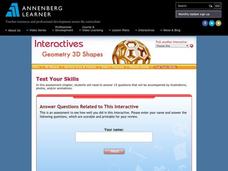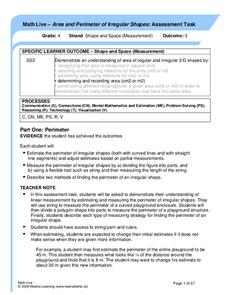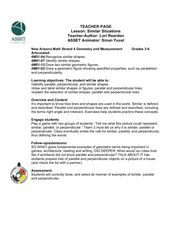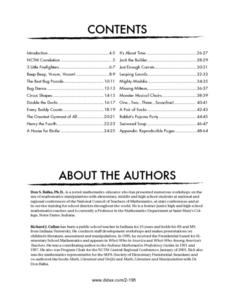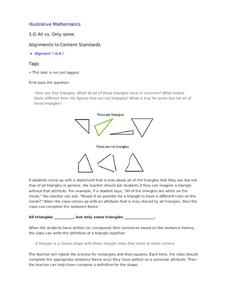Annenberg Foundation
Geometry 3D Shapes: Surface Area and Volume
Whether you wrap it or fill it, you're using geometric concepts. Classmates use an interactive approach to learn how to find volume and surface area of cylinders and prisms in the second lesson in a five-part series. The online lesson...
Annenberg Foundation
Geometry 3D Shapes: Test Your Skills
Time to find out what they've learned! The final lesson of a five-part series has learners complete a 39-question multiple choice review. They use what they've learned in the previous lessons to complete questions that include concepts...
Curated OER
Classifying Three-Dimensional Shapes
Compare geometric solids based on their properties. Your emergent geometers use spaghetti and marshmallows to build models so they can examine the number of faces, edges, and vertices on polyhedra of their own creation. Resource includes...
Alberta Learning
Area and Perimeter of Irregular Shapes
Evaluate young mathematicians' understanding of area and perimeter with this series of three assessment tasks. Challenging students to not only calculate the area and perimeter of irregular shapes, but to explain in writing their...
Teachers Network
A World of Symmetry: Math-Geometry
Define and identify the three basic forms of symmetry translation, rotation, and glides with your class. They cut out and arrange paper pattern blocks to illustrate symmetry, create a Cartesian graph, and design a rug with a symmetrical...
Centre for Innovation in Mamatics Teaching
Area, Perimeter and Volume
Develop young mathematicians' knowledge of two- and three-dimensional shapes with this geometry workbook. From learning about the classifications of different shapes and figures to calculating their area, perimeter, and volume, this...
Curated OER
Shape Hunt
Students explore two-dimensional and solid shapes. In this shapes and patterns geometry activity, students work with a partner to create identifiable objects using tangrams. Students describe the attributes of their shape and their...
Curated OER
It's a 3-D World Out There!
Students construct polygons. They identify attributes of three-dimensional shapes. Students name common three-dimensional shapes. They draw three-dimensional shapes, and sort three-dimensional shapes. Students use K'NEX materials sets to...
Curated OER
Similar Situations
Young scholars explore intersecting lines. In this intersecting lines lesson, students investigate shapes consisting of parallel, perpendicular, and similar lines. Young scholars investigate these lines in shapes around them.
Curated OER
Shapes: Art or Geometry
Budding artists or mathematicians read about,and then draw, two very different shapes. Geometric and organic 2-D shapes are defined. Learners use the definitions to draw examples of each.
Curated OER
Geometric Patterns
Geometric patterns illuminate this colorful and interactive PowerPoint. First, patterns must be identified. Next, students discern the missing color in a block pattern. Lastly, they observe a figure to determine how many blocks are used....
Curated OER
Making Two-Dimensional Shapes
Find the shapes that fit. Pupils explore visual discrimination in a set of geometry worksheets, which has them examine shapes that have been divided in half. They observe a set of shapes to determine which of them would fit into each...
Curated OER
Making Two-Dimensional Shapes
Which shapes fit? Learners practice visual discrimination using a geometry worksheet, which has them examine shapes that have been divided in half. They observe a set of shapes to determine which of them would fit into each half of the...
Curated OER
Shapes in Our World
Help your students explore shapes. They classify shapes and identify them in their everyday world. Plane shapes are explored, and they classify and identify the plane shapes.
Curated OER
Using the Web to Explore Shapes
Third graders research the Internet to locate geometric designs in familiar buildings. They review shapes, solids, angles and symmetry as they research websites of familiar buildings in Louisville. They record the information they see...
Curated OER
Three- and Two- Dimensional Geometry
In this three- and two- dimensional geometry worksheet, 7th graders solve 12 various problems related to geometric shapes and measurement. They first use paper and a pencil to sketch the front, side, back, top and bottom views of each...
Curated OER
Edible Geometry
Learners examine a chart that lists the main characteristics of polygons and 3 dimensional figures. They make examples of the polygons and figures using pretzels and gum drops showing how the gum drops are vertices and the pretzels are...
Curated OER
Living in a Geometrical World
Students participate in a series of hand-on, online, and multimedia activities to examine 2 dimensional and 3 dimensional shapes. They describe common geometric solids. They construct rectangular prisms using straws and ribbon.
Curated OER
Nets and 3 Dimensional Figures
In this nets and 3 dimensional figures activity, 5th graders look at the 3D figure and the net and mark yes or no if it is an accurate representation.
Curated OER
Math-Literature Connection: Counting with Jack the Builder
Connect literature (Jack the Builder) with mathematical concepts. In a series of computation, geometry and number sense activities, pupils count on to add, count back to subtract, build cylinders, cones, and rectangular prisms, and name...
Curated OER
Measurement: 2D and 3D
Students solve volume problems. In this geometry lesson, the class watches a video about clean water (link provided) and individuals compare the volume of different prisms, including an actual drinking glass. Extension activities include...
Science Geek
VSEPR and Molecular Geometry
Many chemistry jokes have no reaction. Presentation begins by explaining what models are and the limitations of various forms before introducing the VSEPR model. Then it outlines the rules for creating a VSEPR model and shows examples of...
Curated OER
Identifying Three-Dimensional Figures (5)
In this shape recognition worksheet, students study the various 3 dimensional figures and identify each one. Students label the 10 figures.
Illustrative Mathematics
All vs. Only Some
All shapes have certain defining attributes that set them apart from others. In order to understand this, young mathematicians look at examples and non-examples of triangles, rectangles, and squares, working as a whole class to create...



